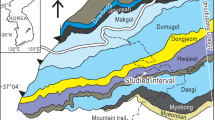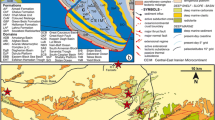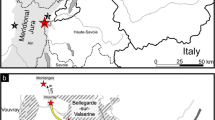Abstract
Limestone breccias are a common phenomenon in the Cambrian successions worldwide. They bear important geological implications that have attracted geologists for several decades. There are, however, still controversies on their origins, especially those of the breccias with abundant vertically orientated clasts. The Furongian (upper Cambrian) Chaomidian Formation of the North China Platform contains numerous levels of limestone breccias and conglomerates that provide an excellent example to look into their formative processes. These breccias and conglomerates have been the focus of study and discussion since the 1980s, but yet there is still no consensus with respect to their geneses. Recently, Van Loon and others argued that the vertically orientated clasts of the breccias developed by a number of simultaneous “fountains” on the paleo-seafloor; the “fountains” formed by upward-directed fluidized flows originated from the sediment underlying the brecciated limestones. While the novel “fountain” hypothesis is not impossible, based on field evidences and theoretical considerations, however, it is most likely that the vertically orientated clasts resulted from their re-orientation by upward flow of thixotropically liquidized, uncemented argillaceous sediment that was interbedded with brecciated limestone fragments. Besides, the deformation processes most likely took place under shallow burial.
Similar content being viewed by others
References
Alfaro P, Delgado J, Estévez A, et al. 2002. Liquefaction and fluidization structures in Messinian storm deposits (Bajo Segura Basin, Betic Cordillera, southern Spain). Int J Earth Sci, 91: 505–513
Berra F, Felletti F. 2011. Syndepositional tectonics recorded by soft-sediment deformation and liquefaction structures (continental Lower Permian sediments, Southern Alps, Northern Italy): Stratigraphic significance. Sed Geol, 235: 249–263
Bouchette F, Seguret M, Moussine-Pouchkine A. 2001. Coarse carbonate breccias as a result of water-wave cyclic loading (uppermost Jurassic-South East Basin, France). Sedimentology, 48: 767–789
Chen J, Lee H S. 2013. Soft-sediment deformation structures in Cambrian siliciclastic and carbonate storm deposits (Shandong Province, China): Differential liquefaction and fluidization triggered by storm-wave loading. Sed Geol, 288: 81–94
Chen J, Chough S K, Chun S S, et al. 2009a. Limestone pseudoconglomerates in the Late Cambrian Gushan and Chaomidian Formations (Shandong Province, China): Soft-sediment deformation induced by storm-wave loading. Sedimentology, 56: 1174–1195
Chen J, Chough S K, Han Z, et al. 2011. An extensive erosion surface of a strongly deformed limestone bed in the Gushan and Chaomidian formations (Late Middle Cambrian to Furongian), Shandong Province, China: Sequence-stratigraphic implications. Sed Geol, 233: 129–149
Chen J, Han Z, Zhang X, et al. 2010. Early diagenetic deformation structures of the Furongian ribbon rocks in Shandong Province of China—A new perspective of the genesis of limestone conglomerates. Sci China Earth Sci, 53: 241–252
Chen J, van Loon A J, Han Z, et al. 2009b. Funnel-shaped, breccia-filled clastic dykes in the Late Cambrian Chaomidian Formation (Shandong Province, China). Sed Geol, 221: 1–6
Chough S K, Kwon Y K, Choi D K, et al. 2001. Autoconglomeration of limestone. Geosci J, 5: 159–164
Cowan C A, James N P. 1992. Diastasis cracks: Mechanically generated synaeresis-like cracks in Upper Cambrian shallow water oolite and ribbon carbonates. Sedimentology, 39: 1101–1118
Ding Y, Bai Z, Liu J, et al. 2008. Multiple origins for flat-pebble limestones and sedimentary environments of the Upper Cambrian Gushan Formation at Tangwangzhai in Shandong Province. J Palaeogeogr, 10: 125–138
Du Y, Xu Y, Yang J. 2008. Soft-sediment deformation structures related to earthquake from the Devonian of the Eastern North Qilian Mts. and Its tectonic significance. Acta Geol Sin, 82: 1185–1193
Du Y, Zhang C, Han X, et al. 2001. Earthquake event deposits in Mesoproterozoic Kunyang Group in central Yunnan Province and its geological implications. Sci China Ser D-Earth Sci, 44: 600–608
Duranti D, Hurst A. 2004. Fluidization and injection in the deep-water sandstones of the Eocene Alba Formation (UK North Sea). Sedimentology, 51: 503–529
Ettensohn F R, Zhang C, Gao L, et al. 2011. Soft-sediment deformation in epicontinental carbonates as evidence of paleoseismicity with evidence for a possible new seismogenic indicator: Accordion folds. Sed Geol, 235: 222–233
Gruszka B, van Loon A J. 2007. Pleistocene glaciolacustrine breccias of seismic origin in an active graben (central Poland). Sed Geol, 193: 93–104
Hurst A, Scott A, Vigorito M. 2011. Physical characteristics of sand injectites. Earth-Sci Rev, 106: 215–246
Kwon Y K, Chough S K, Choi D K, et al. 2002. Origin of limestone conglomerates in the Choson Supergroup (Cambro-Ordovician), mid-east Korea. Sed Geol, 146: 265–283
Li S, Du Y, Zhang Z, et al. 2008. Earthquake-related soft-sediment deformation structures in Palaeogene on the continental shelf of the East China Sea. Front Earth Sci China, 2: 177–186
Mei M, Ma Y. 2003. Sequence stratigraphy of the Late Cambrian strata on the North China Platform and the correlation of the sea-level changes with the North American Platform (in Chinese). Sed Geol Tethyan Geol, 23: 14–26
Mei M, Ma Y, Deng J, et al. 2005. From cycles to sequences: Sequence stratigraphy and relative sea level change for the Late Cambrian of the North China Platform. Acta Geol Sin, 79: 372–383
Moretti M, Ronchi A. 2011. Liquefaction features interpreted as seismites in the Pleistocene fluvio-lacustrine deposits of the Neuquén Basin (Northern Patagonia). Sed Geol, 235: 200–209
Mount J F, Kidder D. 1993. Combined flow origin of edgewise intraclast conglomerates: Sellick Hill Formation (Lower Cambrian), South Australia. Sedimentology, 40: 315–329
Myrow P M, Tice L, Archuleta B, et al. 2004. Flat-pebble conglomerate: its multiple origins and relationship to metre-scale depositional cycles. Sedimentology, 51: 973–996
Pratt B R. 1998. Syneresis cracks: Subaqueous shrinkage in argillaceous sediments caused by earthquake-induced dewatering. Sed Geol, 117: 1–10
Pratt B R. 2002. Storms versus tsunamis: Dynamic interplay of sedimentary, diagenetic, and tectonic processes in the Cambrian of Montana. Geology, 30: 423–426
Ross J A, Peakall J, Keevil G M. 2011. An integrated model of extrusive sand injectites in cohesionless sediments. Sedimentology, 58: 1693–1715
Sepkoski J J J, Bambach R K, Droser M L. 1991. Secular changes in Phanerozoic event bedding and the biological overprint. In: Einsele G, Richen W, Seilacher A, eds. Cycles and Events in Stratigraphy. Berlin: Springer-Verlag. 298–312
Stanistreet I G, Hughes M J. 1984. Pseudoconglomerate and a re-examination of some paleoenvironmental controversies. Geology, 12: 717–719
Tian H, Ma Y, Di M. 1994. Storm deposits of Gushan and Changshan formations at Panchegou region of Xintai in Shandong Province (in Chinese). J Univ Petroleum China, 18: 8–13
Van Loon A J, Han Z, Han Y. 2013. Origin of the vertically orientated clasts in brecciated shallow-marine limestones of the Chaomidian formation (Furongian, Shandong Province, China). Sedimentology, 60: 1059–1070
Wang X. 1981. On the nomenclature, classification, distribution and formative mechanisms of flat-pebble conglomerates (in Chinese). J Mineral Petrol, 5: 31–41
Zhang C, Wu Z, Gao L, et al. 2007. Earthquake-induced soft-sediment deformation structures in the Mesoproterozoic Wumishan Formation, North China, and their geologic implications. Sci China Ser D-Earth Sci, 50: 350–358
Author information
Authors and Affiliations
Corresponding author
Rights and permissions
About this article
Cite this article
Chen, J. Origin of the Furongian limestone breccias in the North China Platform. Sci. China Earth Sci. 58, 770–775 (2015). https://doi.org/10.1007/s11430-014-5011-4
Received:
Accepted:
Published:
Issue Date:
DOI: https://doi.org/10.1007/s11430-014-5011-4




